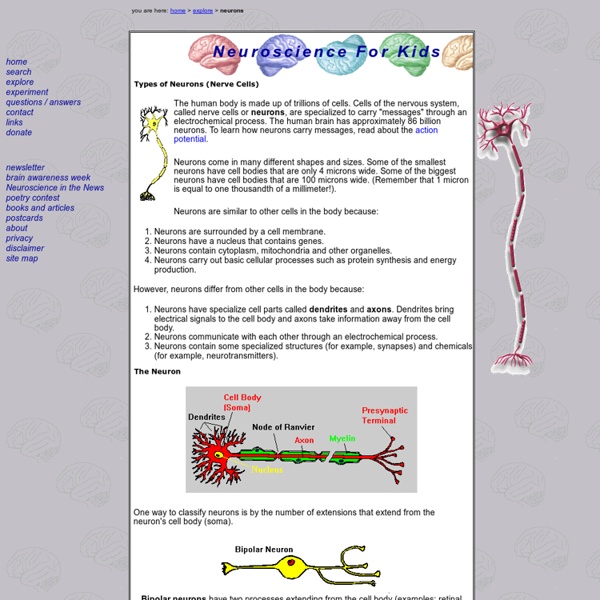Your Brain & Nervous System
Listen How do you remember the way to your friend's house? Why do your eyes blink without you ever thinking about it? Where do dreams come from? In fact, your brain is the boss of your body. Your brain has many different parts that work together. cerebrum (say: suh-REE-brum) cerebellum (say: sair-uh-BELL-um) brain stem pituitary (say: puh-TOO-uh-ter-ee) gland hypothalamus (say: hy-po-THAL-uh-mus) The Biggest Part: the Cerebrum The biggest part of the brain is the cerebrum. <a href=" your favorite way to challenge your brain? When you're thinking hard, you're using your cerebrum. The cerebrum has two halves, with one on either side of the head. Listen The Cerebellum's Balancing Act Next up is the cerebellum. Because of your cerebellum, you can stand upright, keep your balance, and move around. Brain Stem Keeps You Breathing — and More Another brain part that's small but mighty is the brain stem. Listen Pituitary Gland Controls Growth Listen Listen Back
Human Digestive System
Advertisement. EnchantedLearning.com is a user-supported site. As a bonus, site members have access to a banner-ad-free version of the site, with print-friendly pages.Click here to learn more. (Already a member? The human digestive system is a complex series of organs and glands that processes food. Most of the digestive organs (like the stomach and intestines) are tube-like and contain the food as it makes its way through the body. The Digestive Process: The start of the process - the mouth: The digestive process begins in the mouth. On the way to the stomach: the esophagus - After being chewed and swallowed, the food enters the esophagus. In the stomach - The stomach is a large, sack-like organ that churns the food and bathes it in a very strong acid (gastric acid). In the small intestine - After being in the stomach, food enters the duodenum, the first part of the small intestine. The end of the process - Solid waste is then stored in the rectum until it is excreted via the anus.
Circulatory System
As of July 1, 2013 ThinkQuest has been discontinued. We would like to thank everyone for being a part of the ThinkQuest global community: Students - For your limitless creativity and innovation, which inspires us all. Teachers - For your passion in guiding students on their quest. Partners - For your unwavering support and evangelism. Parents - For supporting the use of technology not only as an instrument of learning, but as a means of creating knowledge. We encourage everyone to continue to “Think, Create and Collaborate,” unleashing the power of technology to teach, share, and inspire. Best wishes, The Oracle Education Foundation
Your Lungs & Respiratory System
Listen Time for Talk Your lungs are important for breathing . . . and also for talking! Above the trachea (windpipe) is the larynx (say: LAIR-inks), which is sometimes called the voice box. The amount of air you blow out from your lungs determines how loud a sound will be and how long you can make the sound. Experiment with different sounds and the air it takes to make them — when you giggle, you let out your breath in short bits, but when you burp, you let swallowed air in your stomach out in one long one! Love Your Lungs Your lungs are amazing. Keeping your lungs looking and feeling healthy is a smart idea, and the best way to keep your lungs pink and healthy is not to smoke. Finally, cigarette smoke can damage the cells of the lungs so much that the healthy cells go away, only to be replaced by cancer cells. You can also show your love for your lungs by exercising! Reviewed by: Yamini Durani, MD Date reviewed: October 2012 Originally reviewed by: Laura Inselman, MD
Human Skeleton
Advertisement. EnchantedLearning.com is a user-supported site. As a bonus, site members have access to a banner-ad-free version of the site, with print-friendly pages.Click here to learn more. (Already a member? The human skeleton consists of 206 bones. The longest bone in our bodies is the femur (thigh bone). Joints: Bones are connected to other bones at joints. Differences between males and females: Males and females have slightly different skeletons, including a different elbow angle. Worksheets to Print
Used by medical universities
Gaseous Exchange
Asthma - Important Asthma Triggers
If you have asthma, an asthma attack can happen when you are exposed to “asthma triggers.” Your triggers can be very different from those of someone else with asthma. Know your triggers and learn how to avoid them. Watch out for an attack when you can’t avoid the triggers. Some of the most common triggers are: Tobacco Smoke Tobacco smoke is unhealthy for everyone, especially people with asthma. “Secondhand smoke” is smoke created by a smoker and breathed in by a second person. Dust Mites Dust mites are tiny bugs that are in almost every home. Outdoor Air Pollution Outdoor air pollution can trigger an asthma attack. Cockroach Allergen Cockroaches and their droppings can trigger an asthma attack. Pets Furry pets can trigger an asthma attack. Bathe pets every week and keep them outside as much as you can. Mold Breathing in mold can trigger an asthma attack. Smoke From Burning Wood or Grass Smoke from burning wood or other plants is made up of a mix of harmful gases and small particles.
Asthma and Humidity-Causes and Cures



